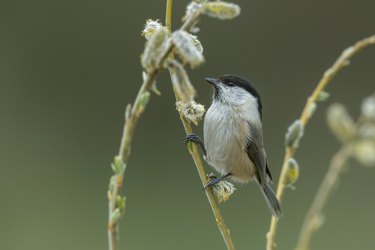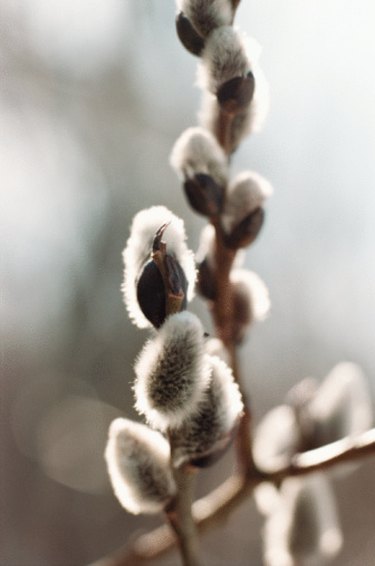
Most of us have a special fondness for those first signals that late winter is giving way to early spring. In much of the continent, one of those signs is the familiar gray catkins of the pussy willow (Salix discolor in North America) emerging. The furry catkins grow on the slender stems of this large bush or small tree, which—as its common name suggests—is indeed part of the larger willow family (Salicaceae).
They're not commonly thought of as an ornamental, but if your taste runs to natural-looking landscaping, you can transplant them successfully from their native habitat. We'll go over how to do just that (and go over some background info on pussy willows) in this guide to transplanting pussy willows.
Video of the Day
Video of the Day
About Pussy Willows
One of the first things to know about pussy willows is that they're dioecious, meaning that each plant produces either male or female catkins. With Salix discolor, the male catkins turn golden as they mature, while the females turn green, which is the source of the "discolor" in their scientific name. For decorative purposes, you'll want to use male pussy willows.

Pussy willows are a native plant across the eastern and northern half of the United States (they'll thrive in USDA plant hardiness zones 4 through 8), and you can find them in wetlands, along ditches or in just about any other place where the soil stays wet. They grow as a cluster of slender stems from a central crown of roots, and depending on conditions, they may remain a small shrub or grow to as much as 20 feet in height.

The catkins provide most of their decorative interest in spring (and pollinators love them too!), but the glossy foliage is attractive in summer. Pussy willows are deciduous and will lose their leaves in autumn, but their slender, graceful stems make them appealing as part of your wintertime landscaping as well.
Propagating Native Pussy Willows
The time to start this project is in early spring, just as the willow catkins are emerging. Choose a spot where you've seen pussy willows in previous years and go looking for stems with male catkins. You're looking for tender new growth—not the old gray stems—at about the thickness of a pencil. Wipe a sharp knife or bypass shears with a cloth soaked in rubbing alcohol (willows are susceptible to infection, so it's important to sanitize your tools) and take one or more cuttings that are 1 to 2 feet in length. That's long enough to put a substantial piece of your cutting underground for stability but short enough that it won't topple under its own weight.

You can start your cuttings in water if you like, but they'll root reliably if you put them directly into soil. Choose a spot in your landscape where they'll get full sun but where the soil is reliably moist. They're a great choice if you have a damp spot that's problematic for other ornamental plants. If you're in a relatively dry climate or don't have an especially damp spot to plant one, dig up the soil in your chosen spot and amend it with lots of organic material to help retain moisture.
If you look at your cutting, you'll see a number of small bumps or "nodes" along the stem. Insert the cut end of your cutting into the ground to a depth of 4 to 6 inches, making sure that at least a few nodes remain above ground (that's where your new growth will come from). "Water in" your cutting thoroughly and keep it well watered for the first four to six weeks as it establishes itself and begins building its new root system.
Warning
Because pussy willows propagate and spread so rapidly, they can become invasive in areas with lots of wetland or marshy areas. If that sounds like where you live, check with your local extension service for tips on confining them to your own property.
Pussy willows’ roots will grow relentlessly in search of moisture, so you really don’t want them anywhere near your home’s water lines, septic system or drainage system.
Transplanting Pussy Willows From a Nursery

You won't usually transplant native pussy willows because willows are thirsty and put down deep, complicated root systems. Digging one up is tedious and unnecessary, given how well they grow from cuttings. However, many nurseries and garden centers offer pussy willow trees as potted saplings that are ready for transplanting into your yard or garden. These are usually European varieties of pussy willow, such as the goat willow (Salix caprea) or gray willow (Salix cinerea). They aren't exactly the same as North American pussy willows, but the differences aren't especially important for landscaping purposes. Each of these species of willow will still give you pretty spring catkins.
As with propagating from cuttings, choose a spot with full sun but moist soil (or create a moisture-retaining soil by adding lots of organic material in an appropriately sunny spot). Begin by digging a hole slightly larger and deeper than the sapling's root ball and add in your amendments. Return enough soil to the bottom of the hole so that the sapling's current "ground level" will be flush with the surrounding soil. Carefully slide your sapling from its pot and stand it upright in the center of the hole. Then, replace the soil around it and tamp it down well.
Tip
If you’re concerned about a habitat for pollinators, by all means, grow pussy willows. They’re an important food source for both native bees and honeybees in the earliest days of spring and are also favored by some species of butterflies. This means you may see caterpillars on your willows, so it’s important not to disturb them until you’ve checked whether they’re a species you want to encourage.
Water your new willow diligently for the first few weeks (if rain doesn't do that for you), but a transplant doesn't need watering as urgently as a cutting. Your transplant already has a fully developed root system and will begin to fend for itself almost immediately.